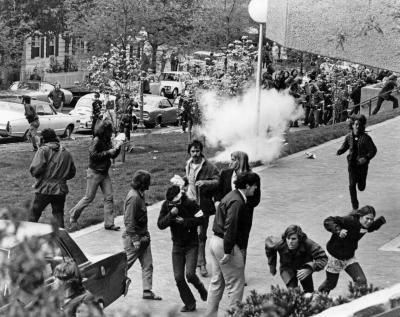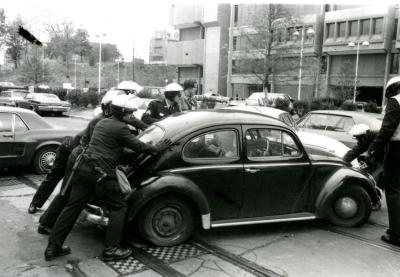In the spring of 1970, Georgetown experienced a wave of student and faculty protests in response to the invasion of Cambodia and the Ohio National Guard's shooting of student protesters at Kent State. The protests led to unprecedented academic disruption, and finals were optional for the first time in school history.
Background
Following President Nixon’s announcement that American and South Vietnamese troops would move into Cambodia, the Georgetown Student Senate voted 20-9 to sanction a two-day boycott of classes. In addition to protesting the Vietnam War, the students sought to call attention to much needed University reforms: reviewing the faculty tenure process, studying the working conditions faced by non-academic staff, fighting air pollution around Georgetown Hospital, and revoking student academic credit for participating in ROTC.1
On Monday, May 4, news broke about the killing of four students at Kent State by national guardsmen. On Tuesday night, Healy Quad became the site of a mass rally with students flying banners featuring the strike's symbol, a red fist.2
Expanding Protests
That Wednesday, the Graduate Student Organization (GSO) and students at the Law Center joined the strike. The GSO voted to suspend all University activity, and the Law Center faculty met that Wednesday and passed a resolution allowing students to delay or take an administrative pass on final exams. Meanwhile, after a day of picketing and teach-ins, the undergraduate student senate reconvened that night where they decided to prioritize opposition to the Vietnam War and the Nixon administration rather than University-specific reforms.3
Academic Consequences
On Thursday, classes resumed, but silent picketers congregated around the classroom buildings. That afternoon, 175 faculty members convened to discuss the strike. At one point, Academic Vice President Thomas Fitzgerald, S.J. proclaimed that those “...who were right on the doorstep of the national government, just could not conduct ‘business as usual.’”4 By a vote of 156 to 13, the faculty voted to suspend the school year. For the first and only time in University history, finals were optional. Few students took them, and professors were given leeway to determine final grades for their students.5 The undergraduate student body president remarked that together, the University President, faculty, and students had “...done much to make Georgetown become a real community.”6
Aftermath
Over the next few weeks, as thousands flocked to Washington, DC, the University opened its doors offering protestors food and a place to stay. Georgetown students during that time remember stepping over sleeping bags and protest signs in common rooms and hallways as they made their way to the bathroom in the morning.7
By the time the fall semester arrived, the University campus had returned to normal.
- 1Telerski, Noah and Shore, Cade. “Having a Grand Old Time: News on the Hilltop from 1969 to 2009.” The Georgetown Voice. 3 April 2019.
- 2Emmett Curran, Robert. “A History of Georgetown University The Rise to Prominence, 1964-89.” 2010, p.147.
- 3Id.
- 4Id. at p.149.
- 5Cuccia, Annemarie. “May 6, 1970: The Day Georgetown Went on Strike.” The Georgetown Voice. 21 Nov. 2020.
- 6 “A History of Georgetown University The Rise to Prominence, 1964-89,” p.150.
- 7“May 6, 1970: The Day Georgetown Went on Strike.”





